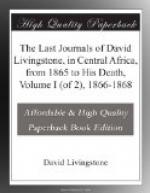I went with the Makonde to see a specimen of the gum-copal tree in the vicinity of this village. The leaves are in pairs, glossy green, with the veins a little raised on both face and back; the smaller branches diverge from the same point: the fruit, of which we saw the shells, seems to be a nut; some animal had in eating them cut them through. The bark of the tree is of a light ash colour; the gum was oozing from the bark at wounded places, and it drops on the ground from branches; it is thus that insects are probably imbedded in the gum-copal. The people dig in the vicinity of modern trees in the belief that the more ancient trees which dropped their gum before it became an article of commerce must have stood there. “In digging, none may be found on one day but God (Mungu) may give it to us on the next.” To this all the Makonde present assented, and showed me the consciousness of His existence was present in their minds. The Makonde get the gum in large quantities, and this attracts the coast Arabs, who remain a long time in the country purchasing it. Hernia humoralis abounds; it is ascribed to beer-drinking.
30th April, 1866.—Many ulcers burst forth on the camels; some seem old dhow bruises. They come back from pasture, bleeding in a way that no rubbing against a tree would account for. I am sorry to suspect foul play: the buffaloes and mules are badly used, but I cannot be always near to prevent it.
Bhang[8] is not smoked, but tobacco is: the people have no sheep or goats; only fowls, pigeons, and Muscovy ducks are seen. Honey is very cheap; a good large pot of about a gallon, with four fowls, was given for two yards of calico. Buffaloes again bitten by tsetse, and by another fly exactly like the house-fly, but having a straight hard proboscis instead of a soft one; other large flies make the blood run. The tsetse does not disturb the buffaloes, but these others and the smaller flies do. The tsetse seem to like the camel best; from these they are gorged with blood—they do not seem to care for the mules and donkeys.
[Illustration: Carved Door, Zanzibar.]
FOOTNOTES:
[3] Dhow is the name given to the coasting vessel of East Africa and the Indian Ocean.
[4] The Commander of H.M.S. Pioneer in 1861.
[5] Those who have read the accounts given by African travellers will remember that the bites inflicted by two or three of these small flies will visually lay the foundation of a sickness which destroys oxen, horses, and dogs in a few weeks.




